Survey 6 Confident Female Fashion

the Transformation of Corset
During the Victorian era, the corset was closely connected with female fashion and social aesthetic. Society morbidly required women to have an extremely thin waist, so a tight corset was necessary for all females. Women’s bodies were facing serious health problems because their bodies were totally distorted by those corsets.

However, because of the rise of women’s social status and the voice against the sacrifice of health, the corset was constantly transformed into easier types. Especially, under the spread of the New Woman ideal, the painful traditional aesthetics towards women had gone together with the end of the Victorian Period. Female clothes went to a more rational style. For heath, the pressure on the waist was much reduced. Corset began to hide more on the hip and legs, and its function even began to show as a bra in later types. Until the modern bra appeared, the corset finally disappeared in female daily clothes.

Dress & Tailored suits
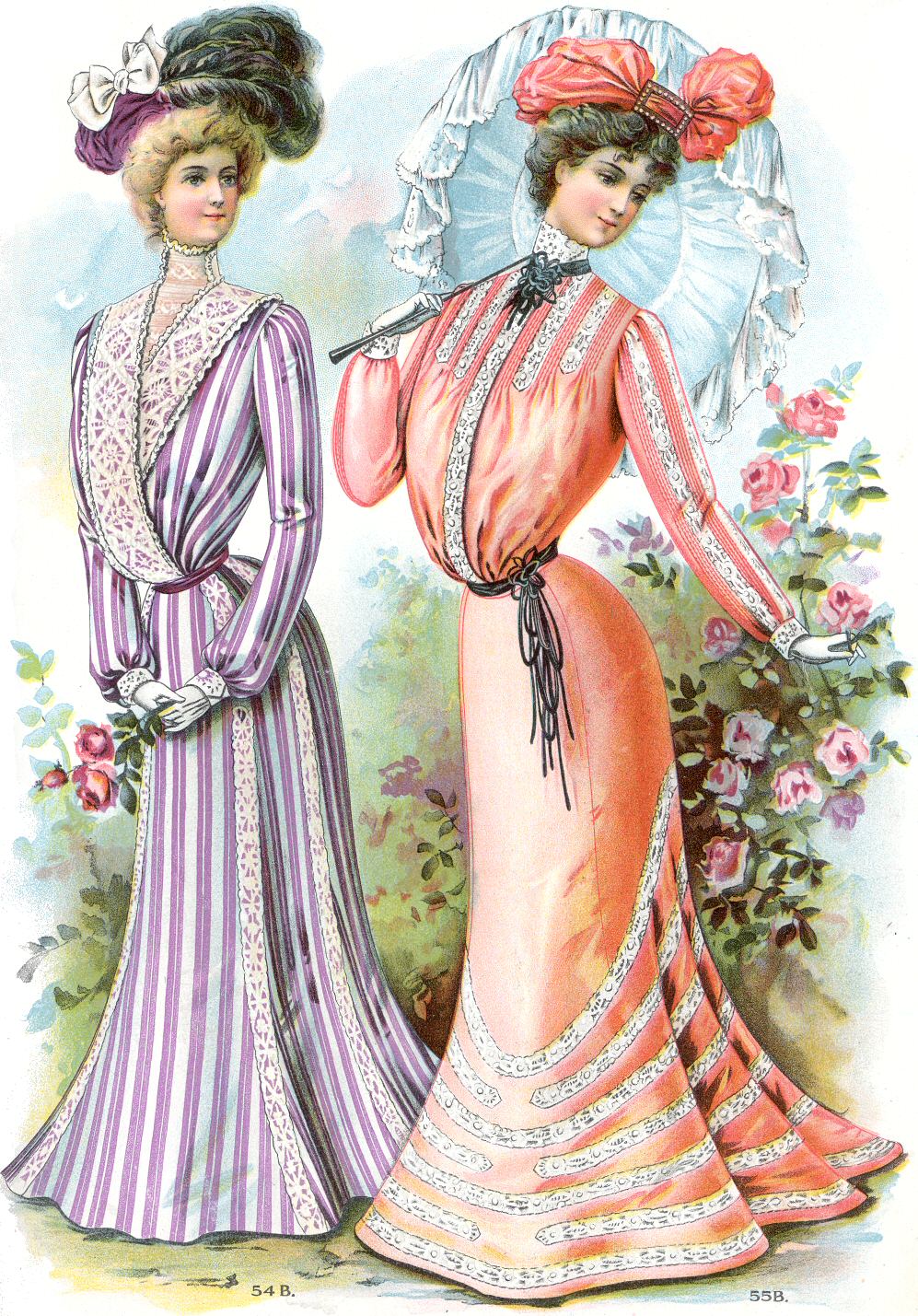
In earlier, due to the left influence of the Victorian Period, the dress was the absolutely custom for women. It was always designed so long that the back was always dragged to the ground. Nevertheless, the shorter dress was always one of the most main pursuits of rational costumes and an active lifestyle. The dress’s length was initially reduced to the level around the ankle. Until the First World War, the dress’s overall silhouette was constantly narrowed and straightened.

Since the more women’s participating in sport and other outdoor movements, more convenient costumes were required. Therefore, the tailored suits became an important cloth in women’s closets. Those suits were much less decorated than the dress, thus women were more masculine and blend into the male-dominated environment. Together with the streamlined dress, those types of cloth had become a new fashion in society at that time. Those all are also accompanied by the fighting of Women’s Suffrage.
References
https://medium.com/@aakankshaagnihotri/fashion-history-scanning-through-1900s-to1919-s-52130c693de3 https://en.wikipedia.org/wiki/1900s_in_Western_fashion https://en.wikipedia.org/wiki/Women%27s_Suffrage_and_Western_Women%27s_Fashion_through_the_early_1900s https://en.wikipedia.org/wiki/Victorian_dress_reform https://www.thefashionfolks.com/blog/20th-century-fashion-history-1900-1910/
Francois Boucher
Francois Boucher (Sept. 29, 1703, Paris, France – May 30, 1770, Paris) was a French painter, draughtsman and etcher. One of the famous Rococo style masters.
Life
- Boucher’s father, Nicolas Boucher, was also a painter, that he gave Bocher his first artistic training when Bocher was young.
- When Boucher was 17, one of his works were admired by Francois Lemoyne, and then Boucher worked as his apprentice for three months until he went to the engraver Jean-François Cars.
- In 1720, Boucher won the elite Grand Prix de Rome for painting, but due to the financial problems at the Académie royale de peinture et de sculpture, it has been 5 years later when he first came to study in Italy.
- After Boucher got back from Italy, he was admitted to the refounded Académie de peinture et de sculpture on 24 November 1731.
- In 1734, Boucher became a faculty member by submitting his Rinaldo and Armida as a reception piece. Then, he was promoted as the Rector of the Academy,
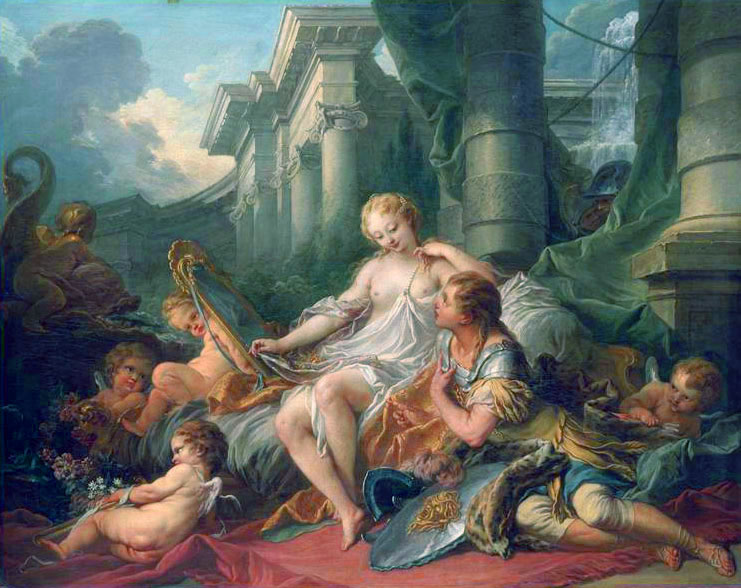
- Until 1765 Boucher had been the First Painter of the King.
- In 1770, Boucher suddenly died in his studio at the Palais du Louvre.
Art Style
Boucher is a very prolific painter, by exaggerated estimating, who has created over 10,000 drawings and 1,000 paintings in his lifetime. Most of his works closely connected with passionate and intimately amorous scenes, including the characterized various females. This made Boucher be attacked on his moral character. Especially in his later works, for example, the Blonde Odalisque was accused of a portrait that illustrated the extramarital relationships of the King.
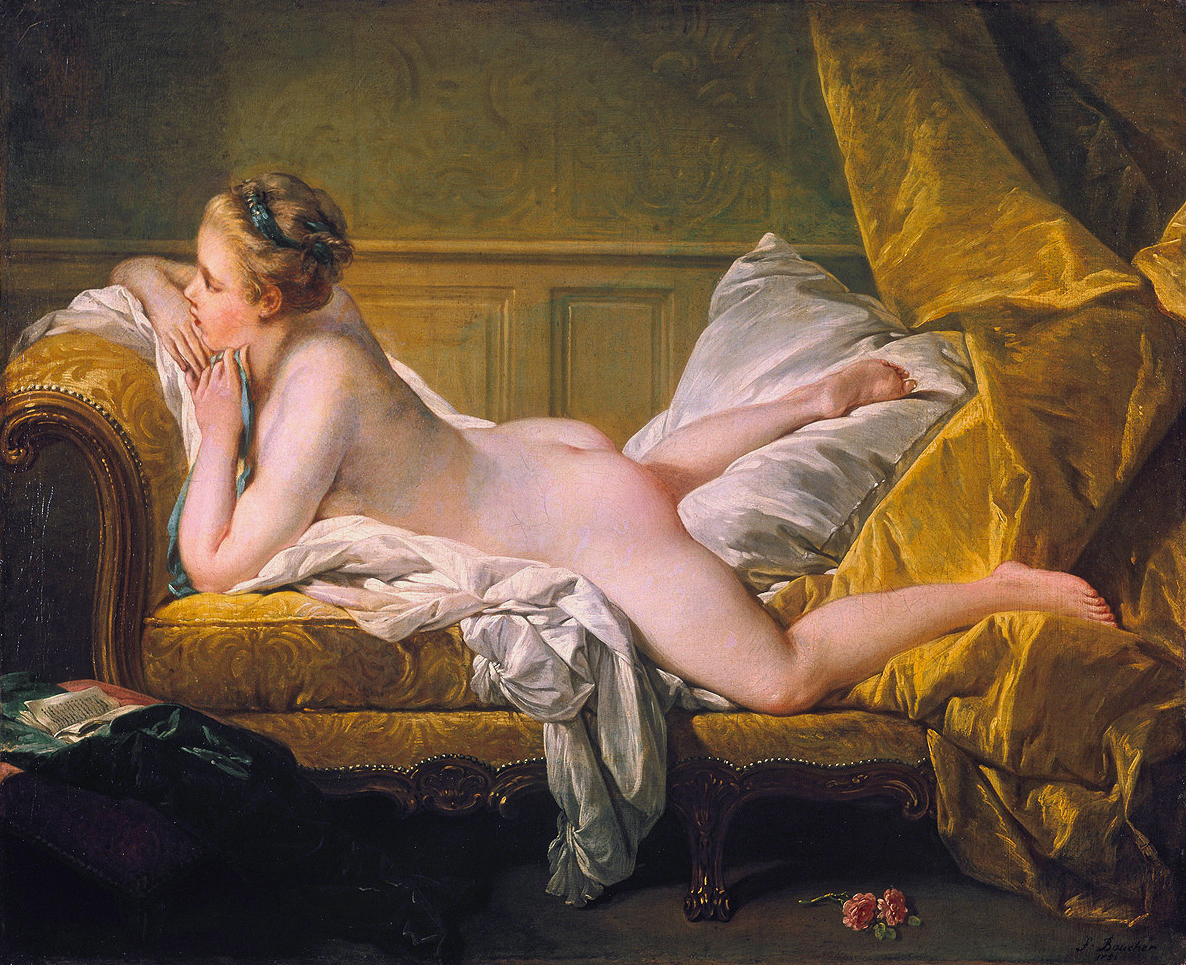
Furthermore, Boucher’s works also reflect the large influence of Chinoiserie on him. He created some Chinese topic paintings full of Chinese elements both based on his imagination and the information from the French East India Company.
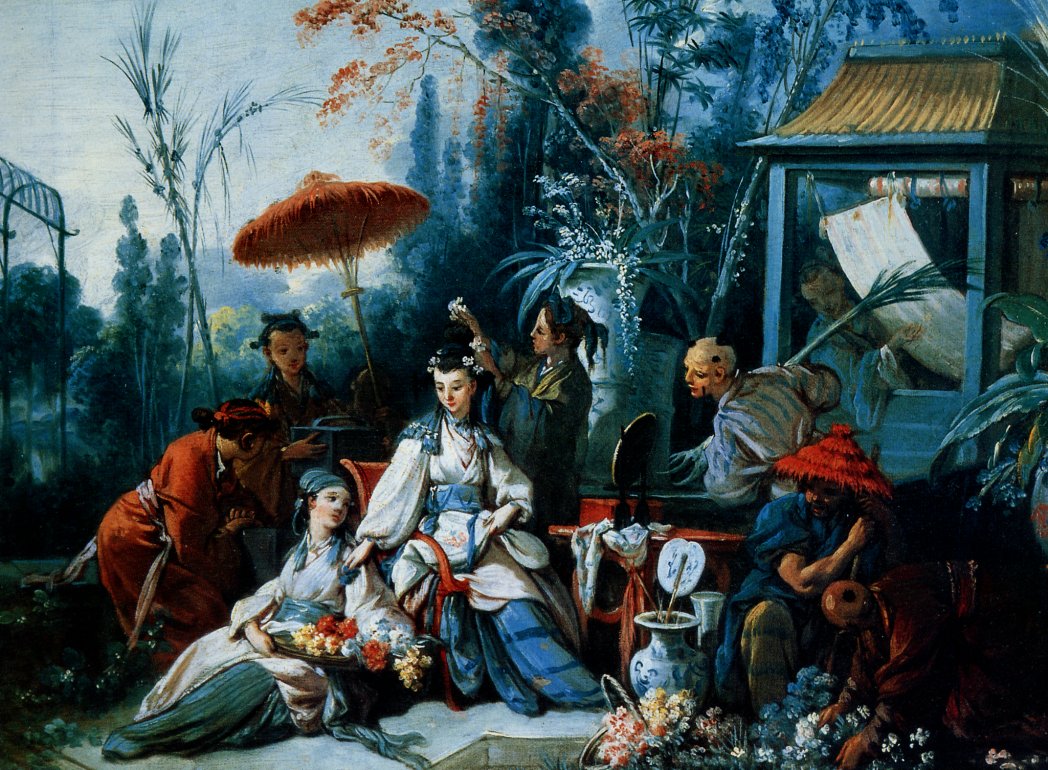
Although Boucher’s art achievement was concealed by the era transformation after his death, he is still a notable Rococo master. His colours and forms had been the symbols of Rococo style, his existence had represented Rococo the word itself.
Personal Opinions
Francois Boucher’s colours make me feel relax and his figure paintings are really vivid. The soft transformation between background and main objects further increased the harmony of his images. I really like that he always set the characters naturally in the environment, that their poses all make me feel comfortable to set in that ways,
References
https://www.theartstory.org/artist/boucher-francois/life-and-legacy/ https://zh.wikipedia.org/zh-cn/%E5%BC%97%E6%9C%97%E7%B4%A2%E7%93%A6%C2%B7%E5%B8%83%E6%AD%87 https://en.wikipedia.org/wiki/Fran%C3%A7ois_Boucher https://www.wikiart.org/en/francois-boucher/all-works#!#filterName:all-paintings-chronologically,resultType:masonry https://baike.baidu.com/item/%E5%BC%97%E6%9C%97%E7%B4%A2%E7%93%A6%C2%B7%E5%B8%83%E6%AD%87/7639319?fr=aladdin https://en.wikipedia.org/wiki/Chinoiserie https://en.wikipedia.org/wiki/French_East_India_Company
SURVEY 5 Artists in Poster Production
Eugène Grasset

Eugène Grasset (25 May 1845 – 23 October 1917) was a Franco-Swiss artist and also one of the Art Nouveau painters. In early, he was taught by François Bocion who had been teaching at the Lausanne École Industrielle for forty years. After graduation, his family took him on a trip to Egypt which had an important influence on his future style. He became interested in Egyptian art and Japanese prints.
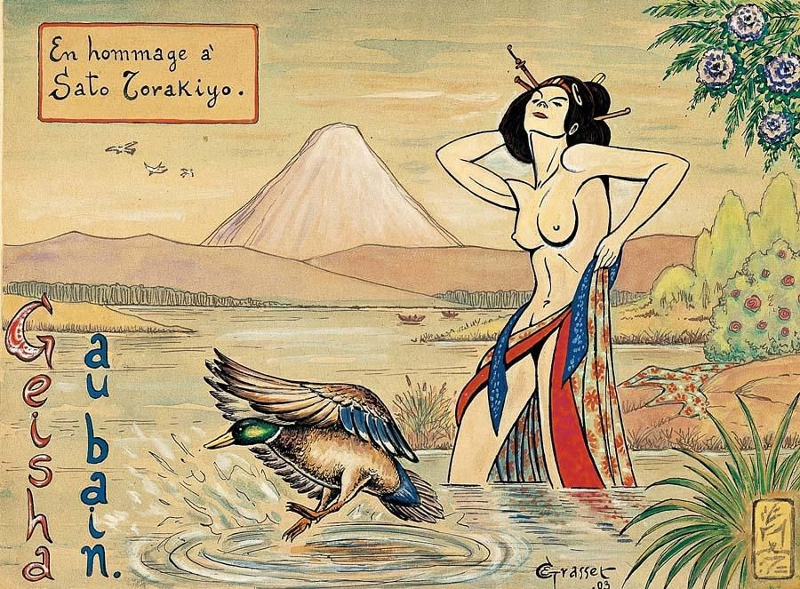
In addition, Grasset’s father was a cabinetmaker and sculptor, that Eugène Grasset was influenced by him so much since he was young because he could have so much practice in these crafts.

Eugène Grasset‘s works were known for delicate elements, such as flowers, trees, and plants, and largely using curvy and circular motifs. The influence of Japanism is obvious, complex lines and float graphic build up a lot of his images.
Alfred Choubrac

Alfred Choubrac ( Paris, 30 December 1853 – Paris, 25 July 1902 ) was a French poster artist. His elder brother, Léon Choubrac (17 November 1847 – 5 April 1885), was also a poster designer, and they were both trained by Charles Doërr and Isidore Pils at the École des Beaux Arts. Afterward, they created the Ateliers Choubrac and work for themselves.

Alfred Choubrac’s works are mainly about the posters for the shows in the Parisian night-life scene of the Belle Époque such as the Théâtre des Variétés, Théâtre du Châtelet, Folies Bergère. Due to this topic, in April 1891, under the orders from the Minister of the Interior, several of Alfred’s posters were prohibited and he was brought to court along with the printers. However, Alfred said that “nudity is exposed everywhere and in much more provocative ways; and I frankly confess that I do not see where the evil was, I sought to make a work of art and nothing more.”
Reference
https://en.wikipedia.org/wiki/Eug%C3%A8ne_Grasset https://www.widewalls.ch/artist/eugene-grasset/ https://en.wikipedia.org/wiki/L%C3%A9on_Choubrac https://en.wikipedia.org/wiki/Alfred_Choubrac https://www.europeana.eu/portal/en/explore/people/118578-alfred-choubrac.html
Survey 4 (Qianlong’s Collections)
Back Ground Summary
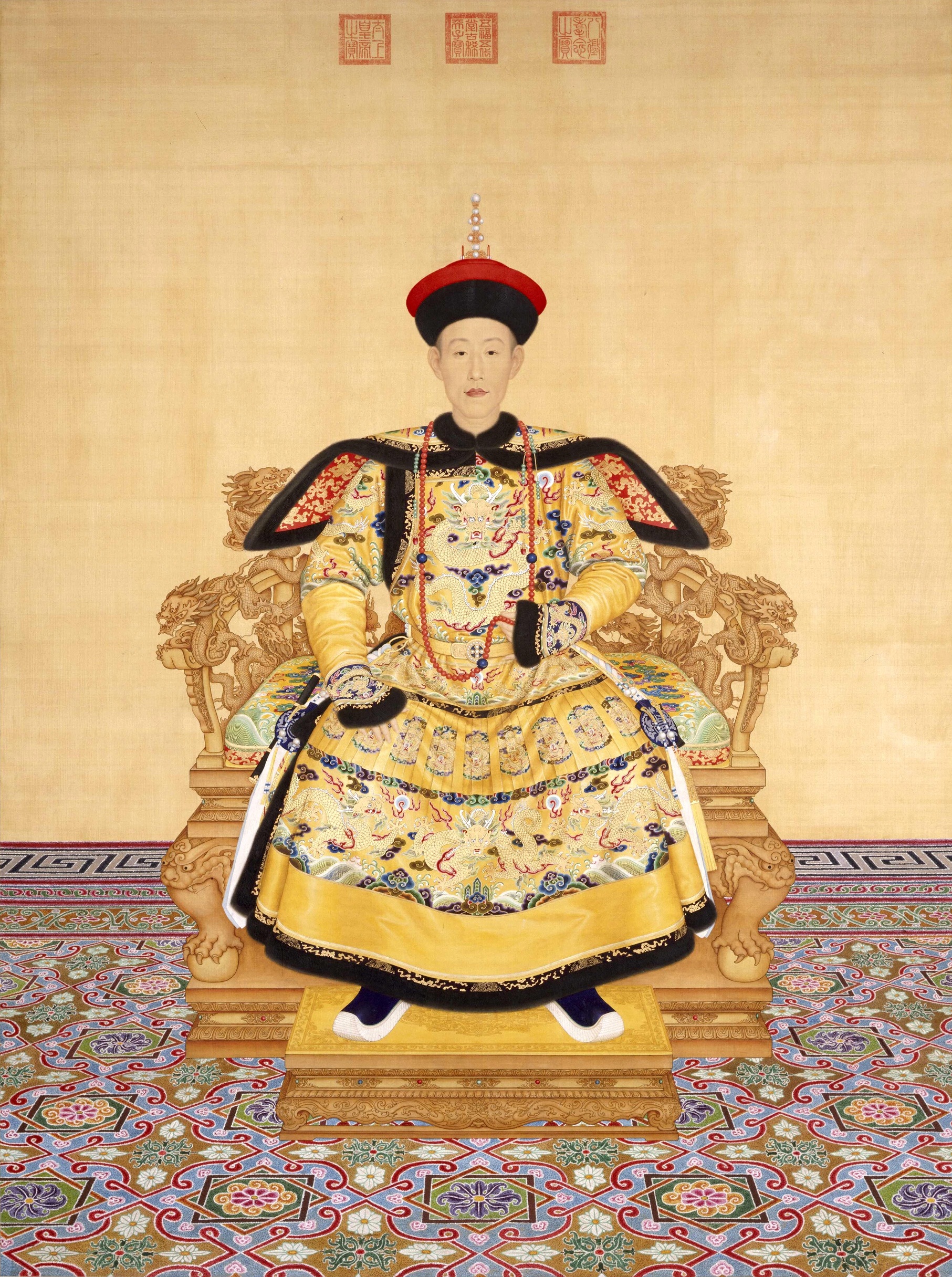
Qianlong is a renowned Emperor in Chinese history, reigned from 1735 to 1796, who is famous for his legendary life. He sustained the previous high-speed development of society in his early and mid periods but lost the control to the internal corruption in later years. However, no matter how controversial he is in political, he absolutely influenced Chinese culture and arts a lot. He was not a very literate person but he really liked to collect literature, arts, crafts, machines, etc; he also travelled around the country many times. In folk stories, he at least six times travelled with a large group of accompanying people to the Jiangnan area. Someone even considers this large amount of expenditure as a reason for the treasury deficit.
Mechanical Clock
Because of the industrial revolution and the increasing communication between eastern and western in that period, more and more people began to tribute something highly scientific instead of traditional treasures to the Chinese emperor. One of the most representative is the mechanical clock which many Chinese emperors liked the most from western. Qianlong was also in love with this novel artificial stuff, especially when this clock is not only mechanical in the movement of the dial. Usually, the whole clocks are made up of complicated device combinations that run the decorations on the appearance, normally including animals, stars, and figures, etc. Qianlong liked the mechanical clock so much and that he even on-site command the production in the palace but not only bought from the western. Since the emperor’s love towards this machine, the craftsmen constantly transformed and reformed it fresh for Qianlong seeing each clock was new. Finally, the clock making technique developed so much that they could even make flowers blooming, pictures changing, text appearing and figures actions on the clock.

Obviously, the style of this clock is deeply influenced by western culture, especially Baroque. In the Qing Dynasty, the Chinese royal family liked this kind of complex appearance very much, and they developed it to more and more complicated patterns.
Revolving Vase
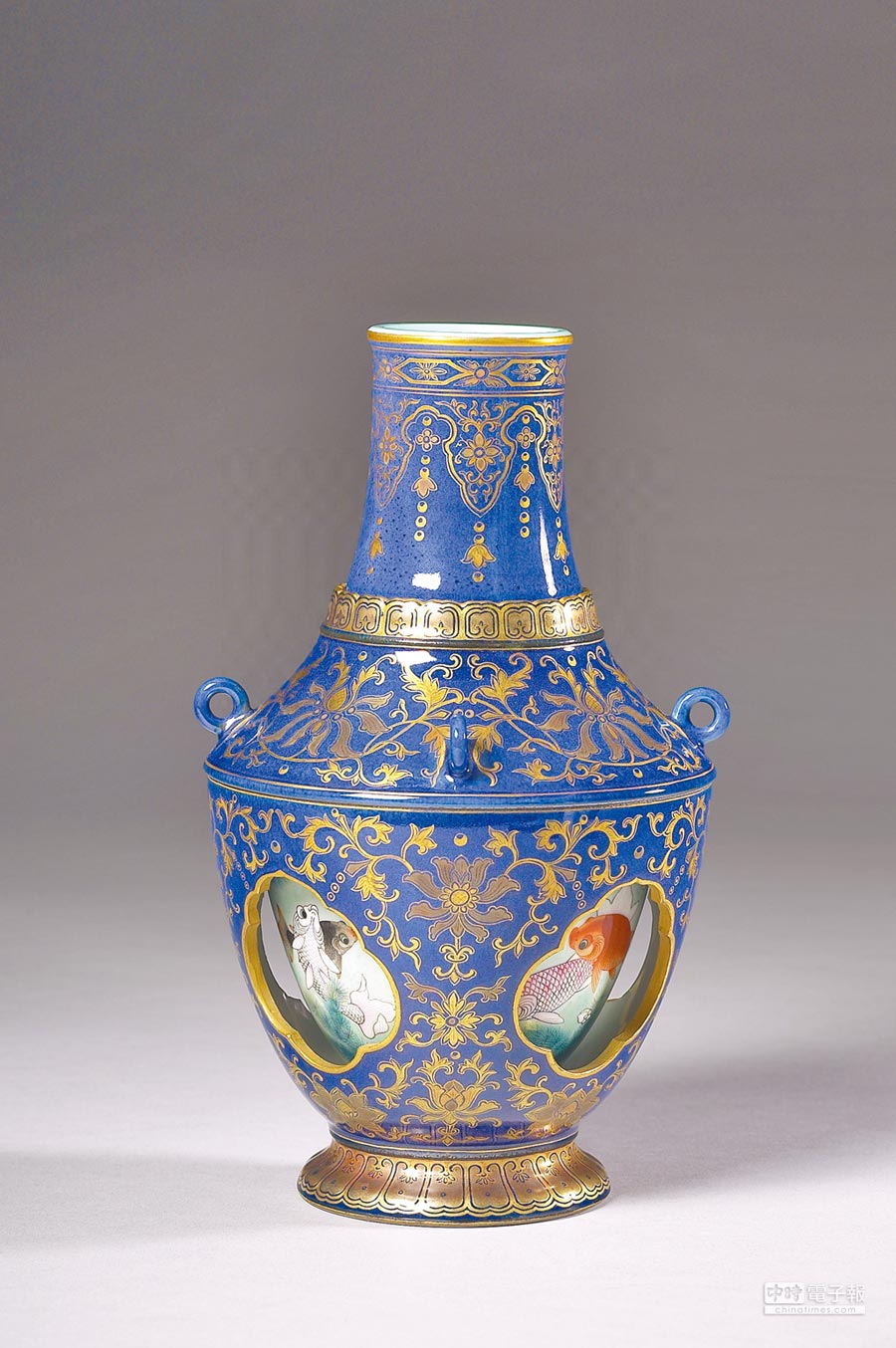
Chinese pottery was highly developed in the Qianlong era, traditional pottery differentiated to diverse forms. One of them is the revolving vase which cleverly combined with the machine. It usually made of the outer vase, inner vase, and a revolving device. For the outside appearance, the outer vase has the hollow patterns which allows people to see the inner vase. Then, the inner vase has pictures on its surface for viewing. During the rotation, the viewed inner vase’s appearance changes. In addition, the type of device determined the outer vase or the inner vase can move.

However, since the technical difficulty and resource wasting, the revolving vases is hard to see except the Qianlong era in Chinese history.
Wenwan(Artworks in the Study Room)
Chinese people named the brush, ink, paper, Inkstone as Four Treasures of the Study in the past. Furthermore, accompany with the prosperity of the Qing Dynasty, more and more people began to truly make these everyday items into works of art. Wenwan is the general name for all of those, and in addition to the above, it also includes pen holder, pen washer, ink bed, paperweight, printing box, seal, etc, and even walnut.

Ink Container 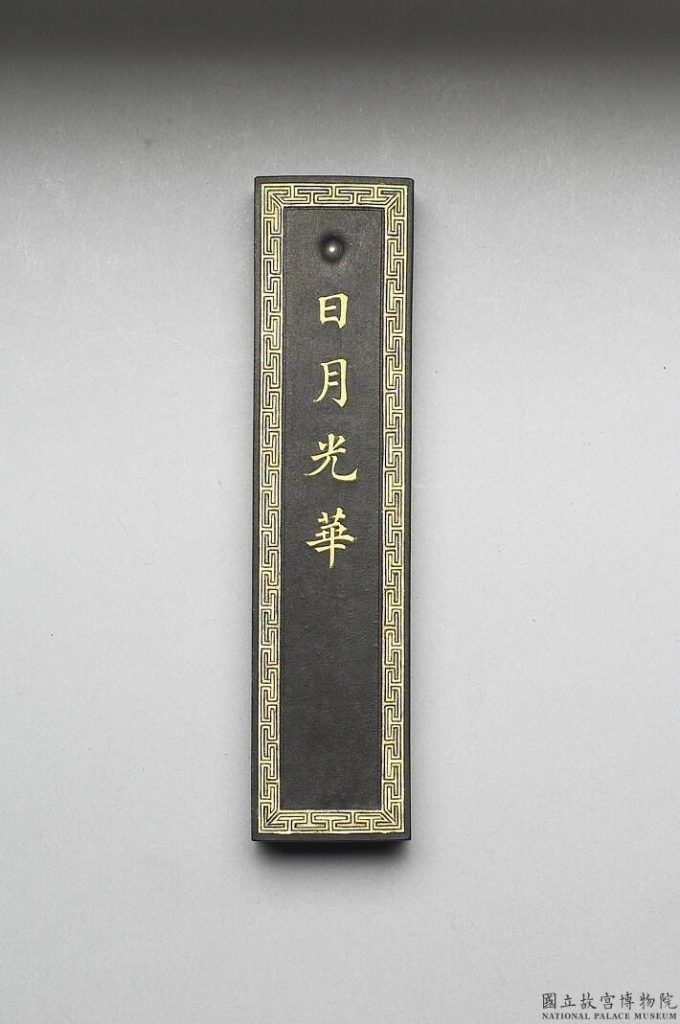
Front of the Ink 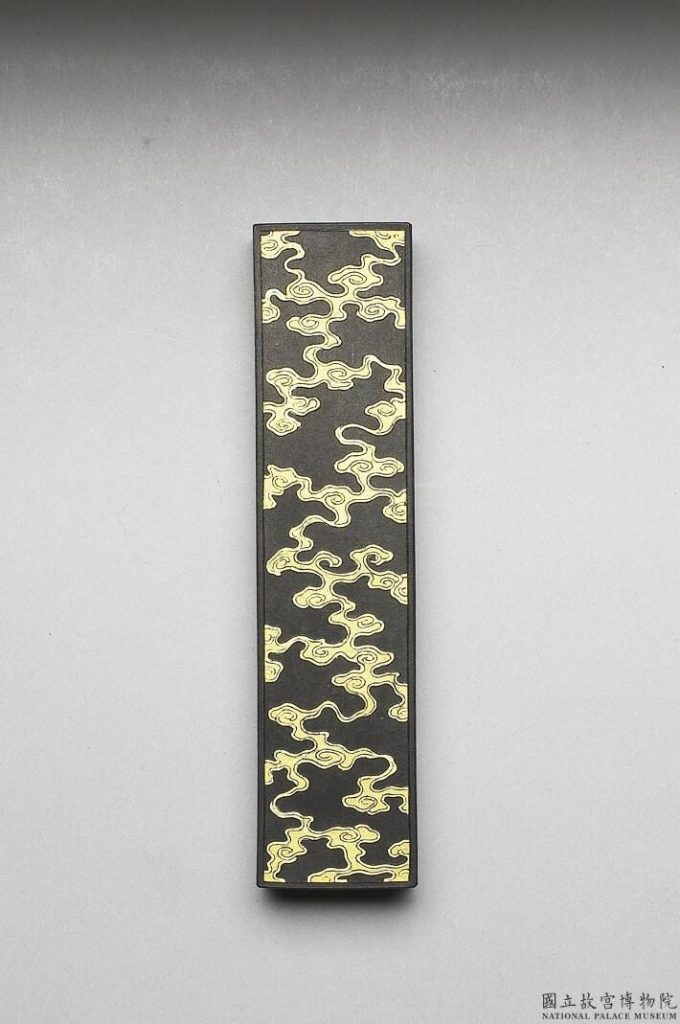
Back of the Ink
Above is one of Qianlong’s ink collections which decorated by golden patterns. The text means the essence of the sun and the moon.
References
https://upload.wikimedia.org/wikipedia/commons/1/16/%E6%B8%85_%E9%83%8E%E4%B8%96%E5%AE%81%E7%BB%98%E3%80%8A%E6%B8%85%E9%AB%98%E5%AE%97%E4%B9%BE%E9%9A%86%E5%B8%9D%E6%9C%9D%E6%9C%8D%E5%83%8F%E3%80%8B.jpg http://fashion.163.com/13/0805/14/95H72VIO00264MK3_mobile.html http://bbs.1shoucang.com/data/attachment/forum/201305/08/101719ohhgw6wwwhax4lql.jpg http://antiquities.npm.gov.tw/Utensils_Page.aspx?ItemId=6 https://zhuanlan.zhihu.com/p/44012334 http://imgsrc.baidu.com/baike/pic/item/6a63f6246b600c33b196edeb174c510fd9f9a121.jpg
Survey 3( Isaac Newton& Gravity)
Isaac Newton, one of the most famous physicists, was born on 4 January 1643, at Woolsthorpe Manor in Woolsthorpe-by-Colsterworth. No need to more explain his life, he is too famous hard to introduce him differently for avoiding repeating of the same stories. Now, just directly reflecting on his achievement in finding gravity.

A widely known story is that after Newton was hit on the head by a fallen apple, he began to think of the reason why the apples fall but the stars do not. After serious reflection, smart Newton got the answer, gravity. However, truth is not only a straightforward fairy tale.

First off, Newton was considering why the apples always just straightly fall down but not gone up or change its direction of movement in the air. Then, he presumed the existence of something that attracts the apples to move towards the center of the Earth. This is the most initial gravity, and then he tried to calculate if this theory is workable for the moon which is much larger and far away. Afterward, by comparing his calculated result with the observed information, he got the answer that everything has this kind of ability to influence all the other stuff.
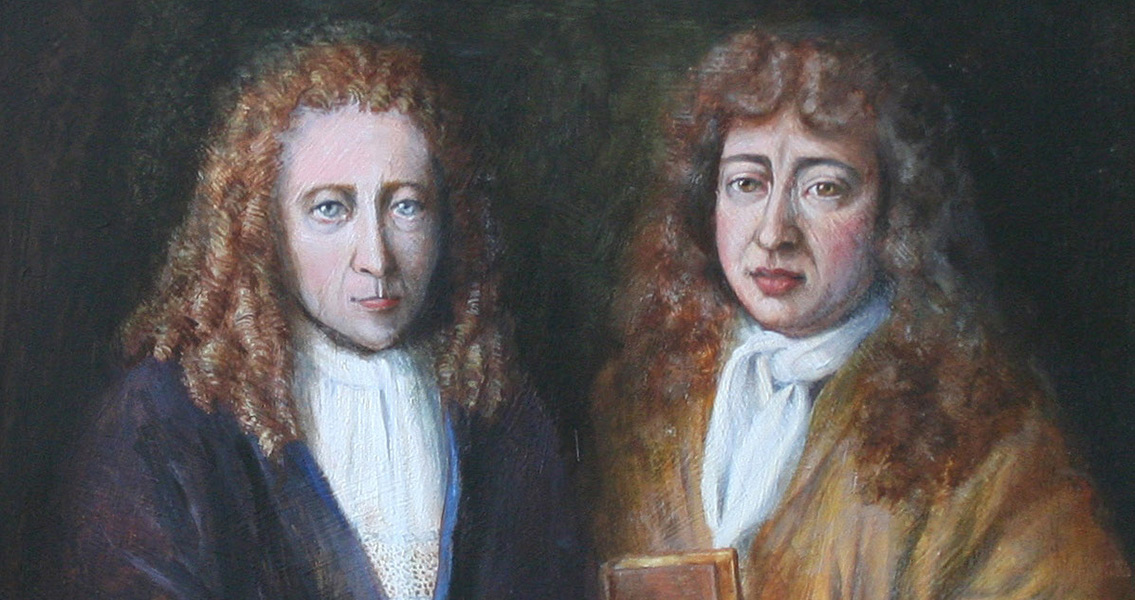
Nevertheless, except technically the unimaginable amounts of calculation and observation for the moon, one of the well-known problems is the conflict between Newton and Robert Hooke. Indeed in the earlier time, about the exploring of Opticsn, light, Hooke strongly opposed Newton’s hypothesis and thesis. They were endlessly struggling with each other in that period, and even when Newton was calculating the gravity, he was fighting with Hooke in the letter. Finally, when Newton proved the existe of gravity, Hooke was also clamming that find gravity is his achievement but not Newton. Ultimately, those increasing discord caused a serious problem after Hooke dead. Newton destroyed all the portrait of Hooke and was even trying to clean all Hook’s personal information.
References
https://images-na.ssl-images-amazon.com/images/I/61zOAr3OsJL.SL1001.jpg https://www.newhistorian.com/2016/08/22/robert-hooke-wrath-isaac-newton/ https://en.wikipedia.org/wiki/Isaac_Newton#Mechanics_and_gravitation https://en.wikipedia.org/wiki/Robert_Hooke
Survey 2 (French Gothic Architecture)
Amiens Cathedral

The biggest church in France, Amiens Cathedral, was built between 1220 and 1270. The surface area is 7,700 square meters and 126 pillars support its space. As one of the oldest French Gothic buildings, it locates in Amiens beside River Somme and about 120 kilometres north of Paris.
The Exterior
Amiens Cathedral’s doors of the central portal are divided by a trumeau with a statue of the Christ. They are flanked on both sides with images of the apostles. When people lookup in front of the portal, they will see numerous angles, martyrs, and virgins with the Tree of Jesse forming the outer ring. Above the portals, a gallery and a row of 22 oversized statues of kings are illustrated. Furthermore, the chevet of Amiens Cathedral displays standard Gothic characteristics including flying buttresses. By the way, the original facades were full of colours and we can see that again by modern technology.
The Interior
There are also numerous interior decorations in Amiens Cathedral. The great collection of statues at Amiens would later be known as “the Bible of Amiens”. For example, the baroque pulpit, made of marble and gilded wood. It is hold by the three allegorical female figures, apparently representing Faith, Hope and Charity, the three Theological Virtues. Furthermore, a large amount of survived stained glasses are also rare after frequent wars.
For architecture itself, the enormous size of the building will impress the visitor immediately. People normally walk into the church by side aisles, which are at a height of 20 m almost double that of Notre Dame in Paris. Nevertheless, the pillars still seem to rise more and more. Afterward, most of the glass in the nave is clear which allowing the church to be flooded by natural light.

References
https://upload.wikimedia.org/wikipedia/commons/7/7e/Amiens_Cathedral%2C_1903.jpg https://i1.wp.com/frenchmoments.eu/wp-content/uploads/2012/12/Amiens-Cathedral-©-Thierry80-licence-CC-BY-SA-4.0-from-Wikimedia-Commons.jpg?fit=1500%2C997&ssl=1 https://www.european-traveler.com/france/visit-amiens-cathedral-largest-gothic-church-france/ https://upload.wikimedia.org/wikipedia/commons/2/28/Amiens_cathedral_illuminated.JPG https://frenchmoments.eu/amiens-cathedral/ https://upload.wikimedia.org/wikipedia/commons/2/2c/0_Amiens_-Cath%C3%A9drale_Notre-Dame%281%29.JPG
Jan Vermeer( Johannes Vermeer)
Jan Vermeer(Johannes Vermeer) was one of the greatest Dutch artists in the Dutch Golden Age. He is famous for his technique and treatment of the light using in his works. For easier to immediately understand him, below, one of the most famous paintings, Girl with a Pearl Earring, is his works.

Life
Vermeer was born on October 31, 1632, in Delft, Netherlands. His childhood is a mystery but someone said that Vermeer began to learn about art around the middle of the 1640s. His father, Reynier Vermeer, was an art dealer and silk weaver who probably was the earliest art enlightenment for Jan. However, his father dead in 1652, and then probably Vermeer took over his businesses of art and inn.
In April 1653, Jan Vermeer married Catharina Bolenes, who is from a wealthful Catholic family. They had 15 children, but this might be the reason for their unfortunately poor life. On 29 December, Vermeer joined the Guild of Saint Luke, which an art association helped Vermeer sold his works.
1672 the Rampjaar, disaster year, came, the Dutch Republic was almost crushed by the attack from France, Britain and other powers. Vermeer’s life is totally destroyed by this catastrophe. His arts were hard to sell and he almost had no economic income for years. Ultimately, Vermeer and his family moved to the home of his wife’s mother, Maria Thins. Until 15 December 1675, he suddenly died of illness.
His wife described his death by
“ …during the ruinous war with France he not only was unable to sell any of his art but also, to his great detriment, was left sitting with the paintings of other masters that he was dealing in. As a result and owing to the great burden of his children having no means of his own, he lapsed into such decay and decadence, which he had so taken to heart that, as if he had fallen into a frenzy, in a day and a half he went from being healthy to being dead.“
Art Style
In early, the warm colours of The Procuress relate Jan Vermeer’s style to the Rembrandt school, but the topic and composition displayed the influence of the Utrecht Caravaggism, of Caravaggio.

The Soldier and Laughing Girl noted the shift of Vermeer’s style because the pointillism first time appeared in his works.

Jan Vermeer usually made the light comes from the left in his works and used the light to build contrast with the shadings on the figures. He liked using yellow, blue and gray. Although some of those pigments are extremely expensive in that period, such as the lapis lazuli, he still used a lot of them in his arts even after his life was very impoverished after the Rampjaar.
Since the unimaginable details in Vermeer’s arts and his close relationship with Antonie van Leeuwenhoek, who invented single-lensed microscopes, a lot of people believe that Vermeer used camera obscura to support his creation.
Personal Opinions
Jan Vermeer is an unfortunate master. Although only a few of his works left now, we can still see what a strong dominance towards the light. His light is not so exactly sharp like Caravaggio, but more is a kind of gentle and warm. It makes me feel peaceful and comfortable, and even kind of truly touched with the warm light. His figures are not like others too, that are more normal and realistic. I really Raphael’s figures, but his paintings still are something untouchable that far away from life, however, Vermeer’s paintings are the absolutely normal humans. This sets the audiences closer to the art itself.
References
https://www.notablebiographies.com/Tu-We/Vermeer-Jan.html https://upload.wikimedia.org/wikipedia/commons/b/b0/Johannes_Vermeer_-The_Procuress-_Google_Art_Project.jpg https://upload.wikimedia.org/wikipedia/commons/2/2e/Johannes_Vermeer_-De_Soldaat_en_het_Lachende_Meisje-_Google_Art_Project.jpg https://upload.wikimedia.org/wikipedia/commons/d/d7/Meisje_met_de_parel.jpg https://en.wikipedia.org/wiki/Johannes_Vermeer
Raffaello Sanzio da Urbino
Life:
Raffaello Santi is a Famous Italian painter, who was born in 1483, Urbino.he had a nice family and had a good time in childhood, it formed his modest gentle personality. His father was an artist and teach him drawing when he was a child, a few years later he learned from Pietro Perugino. However, his parent died before his 11 years old.
in 1504, he decided stayed in Florence. At the same time, he painted “the “Marriage of the Virgin ”, this work even surpassed Perugino, and all his painting of virgin all show gentle mother. He is influenced by local thoughts and also learns the composition of Leonardo da Vinci and the body expression and style of Michelangelo.

1509, He was invited by the Pope Julius II to paint the Vatican frescoes. The murals in the signature hall are the most outstanding. those murals represent theology, philosophy, poetics and jurisprudence, respectively. Many good paintings also came out at the same time.
Style development:
In Raphael’s early life, he is strongly influenced by his master, Pietro Perugino. This can be seen by comparing his “Marriage of the Virgin” to Perugino’s “Christ Handing the Keys to Saint Peter”.
In Florence, Raphael’s art style develops a lot. For example, Raphael creates more works in pen and ink, his drawings have more figures, and the sense of movement becomes more powerful. Now, those are usually considered as the influence of the local awakening humanism and the other Florentine artist, such as Leonardo da Vici.

In later years, Raphael’s works show that he had deeply learned in Venetian art. His oil paintings and fresco paintings display that he paid more attention to colour and light, which is the main characteristics of Venetian art. Furthermore, some the ranges of impasto in his oil paintings are unprecedented, thus this is assumed as the rare innovation of Raphael.

Personal opinion
Raphael’s art represents the human awakening in humanism. His figure drawings are not like the earlier artists’ empty figures. Those of Raphael’s paintings are more accompanied by human thoughts and spirits because he more focused on the individuals depicting. In his drawings, each of his characters is considered as a living person but not only a copy of a human. This method made him a soft style in early and created more and more vivid figures after he arrived Florence
References
https://www.artble.com/artists/raphael/more_information/style_and_technique
https://en.wikipedia.org/wiki/Raphael
https://upload.wikimedia.org/wikipedia/commons/0/06/Raffaello_-Spozalizio-_Web_Gallery_of_Art.jpg https://upload.wikimedia.org/wikipedia/commons/f/f2/Raffael_026.jpg https://upload.wikimedia.org/wikipedia/commons/4/49/%22The_School_of_Athens%22_by_Raffaello_Sanzio_da_Urbino.jpg
Hugo van der Goes
Life
Birth: Hugo van der Goes does not have an exact record for his birth but he is usually considered as born at Ghent or its environs in around 1440.

Early: Nothing documented about Hugo van der Goes, until he became a master in the painters’ guild of Ghent in1467. In the future years, he was required to make some decorations for events like papal blazons. For instance, 1468, van der Goes created decorations in the town of Bruges for celebrating the marriage between Charles the Bold and Margaret of York. Thereafter, he became more and more famous.
Highpoint: In around 1477, Van der Goes had achieved sizable reputations and secured important commissions from the Burgundian court, the church, and the rich peoples. However, Van der Goes choose to be a frater conversus (a lay brother) when it was the peak of his career. At the monastery, he had certain privileges such as allowed to continue to drink wine and to work on the painting.

Death: Hugo van der Goes died in the Rood Klooster in 1482. According to the cloister chronicler Ofhuys, Hugo van der Goes was suffering in an acute depression. After Hugo van der Goes unsuccessfully tried to suicide, his companions brought him back to Brussels and then to the Rood Klooster. Unfortunately, he died shortly thereafter and was buried in the atrium of the cloister.
Art Style
The early styles of Hugo van der Goes’s works are usually considered as a kind of illusionism which uses rich colours and a single vanishing-point perspective to build up a detailed description in pictures. For example, the centre panel of the Portinari Altarpiece.
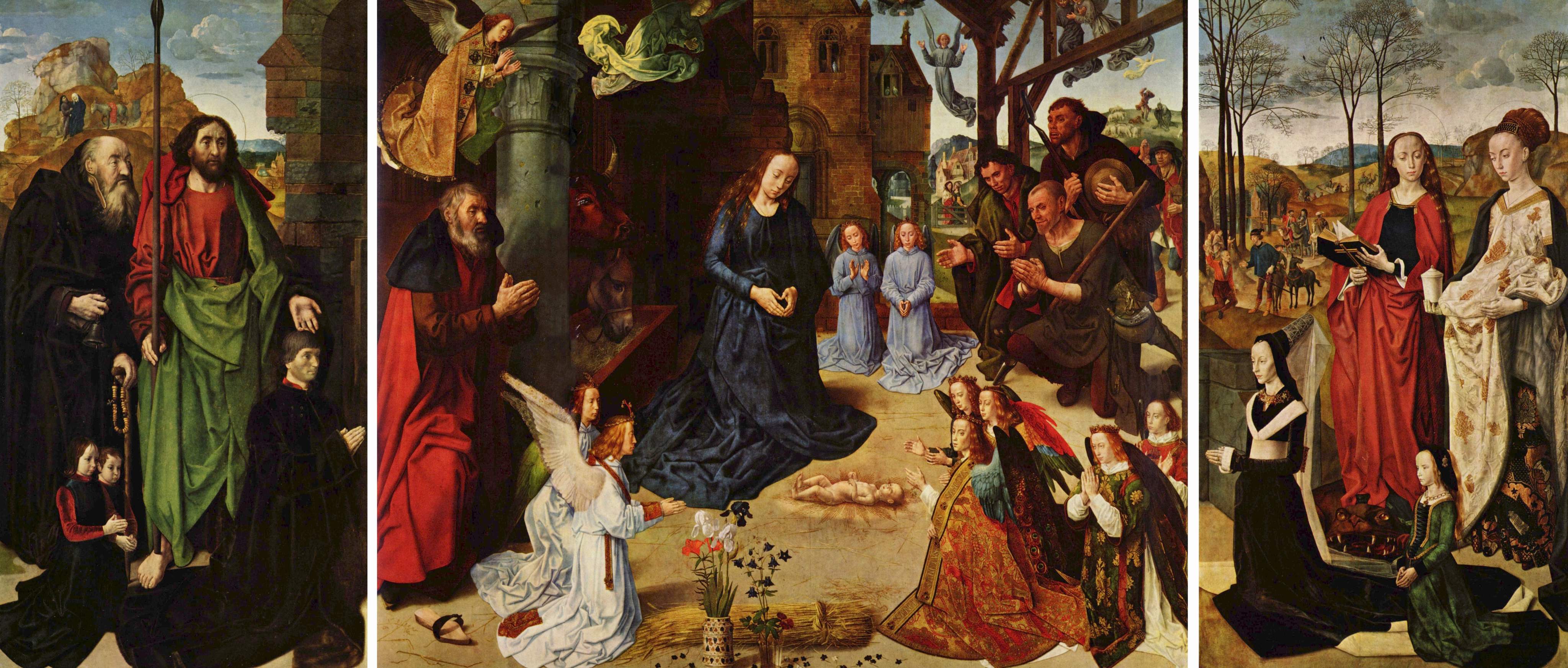
In addition, the Portinari Altarpiece is the sole of surviving works that can be confidently linked to Hugo van der Goes. Later, his style pays more attention to the artificiality which built by the limited range of colours and the expressive distortion of figures as well as space. Afterward, he is also an important artist in portrait drawing. He made the portrait more real by increasing the details and shadings on the face and then let them look at something to make those characters look like having an experience of vision. Those developing techniques of the portrait drawing are usually considered as an individually cognitive awakening of human beings in those periods.
In my opinion, Hugo ver der Goe was one of the first pioneers who begin to challenge the unexplored region of art. However, he was still only one of the traditional artists who work for the church. Although there are a few changes in the portrait drawing and overall composition, most of his works still tightly connect with the style of Christian art. There is nothing much about his personal art pursuit and understanding in the inner of his works. He had not really expressed his thoughts and cognition in his arts yet. All in all, Hugo ver der Goe who is good enough as a successful artist in the early Renaissance.
References
https://en.wikipedia.org/wiki/Monforte_Altarpiece https://en.wikipedia.org/wiki/Adoration_of_the_Shepherds_(Hugo_van_der_Goes)
https://en.wikipedia.org/wiki/Portinari_Altarpiece